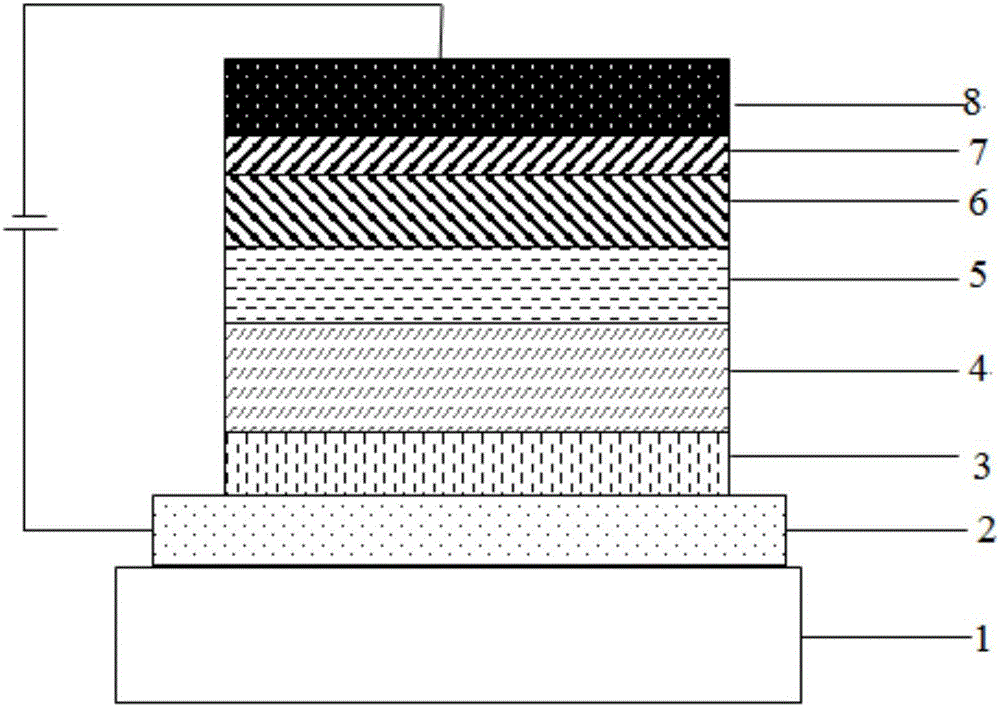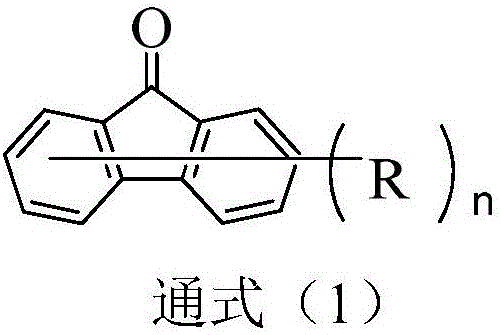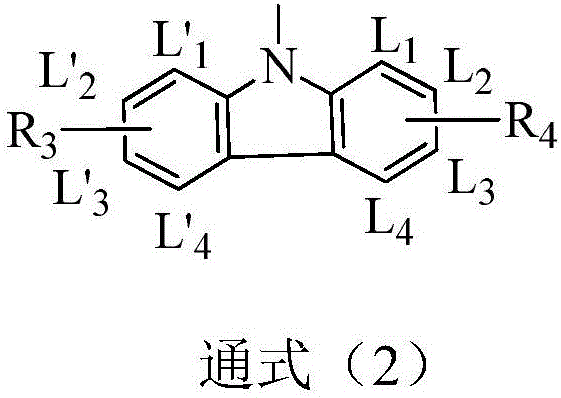Compound with 9-fluorenone as core and application thereof
A compound, boric acid compound technology, applied in the fields of organic chemistry, electrical components, circuits, etc., can solve the problems of efficiency roll-off, low S1 state radiation transition rate, difficult exciton utilization rate and high fluorescence radiation efficiency, etc., to reduce efficiency. Roll-off, good film formation, improved exciton utilization and high fluorescence radiation efficiency
- Summary
- Abstract
- Description
- Claims
- Application Information
AI Technical Summary
Problems solved by technology
Method used
Image
Examples
Embodiment 1
[0059] Embodiment 1: the synthesis of compound 6:
[0060] synthetic route:
[0061]
[0062] In a 250mL three-neck flask, under a nitrogen atmosphere, add 0.01mol 2,7-dibromo-9-fluorenone, 0.025mol intermediate A1, 0.03mol sodium tert-butoxide, 1×10 -4 molPd(dppf)Cl 2 , 180mL toluene, heated to reflux for 10 hours, sampled and spotted, the raw materials were completely reacted; naturally cooled to room temperature (20-25°C), filtered, and the filtrate was collected for vacuum rotary evaporation (-0.09MPa, 85°C), and column chromatography , to obtain the target product with a HPLC purity of 99.2% and a yield of 68.5%.
[0063] Elemental analysis structure (molecular formula C 55 h 38 N 2 O): theoretical value C, 88.92; H, 5.16; N, 3.77; O, 2.15; tested value: C, 88.93; H, 5.15; N, 3.76;
[0064] HPLC-MS: The theoretical molecular weight of the material is 742.90, and the measured molecular weight is 743.13.
Embodiment 2
[0065] Embodiment 2: the synthesis of compound 12:
[0066] synthetic route:
[0067]
[0068] In a 250mL three-neck flask, under a nitrogen atmosphere, add 0.01mol 3,6-dibromo-9-fluorenone, 0.025mol intermediate A1, 0.03mol sodium tert-butoxide, 1×10 -4 molPd(dppf)Cl 2 , 180mL toluene, heated to reflux for 10 hours, sampled and spotted, the raw materials were completely reacted; naturally cooled to room temperature (20-25°C), filtered, and the filtrate was collected for vacuum rotary evaporation (-0.09MPa, 85°C), and column chromatography , to obtain the target product, HPLC purity 98.8%, yield 67.7%.
[0069] Elemental analysis structure (molecular formula C 55 h 38 N 2 O): theoretical value C, 88.92; H, 5.16; N, 3.77; O, 2.15; tested value: C, 88.95; H, 5.13; N, 3.78;
[0070] HPLC-MS: The theoretical molecular weight of the material is 742.90, and the measured molecular weight is 743.18.
Embodiment 3
[0071] Embodiment 3: the synthesis of compound 22:
[0072] synthetic route:
[0073]
[0074] In a 250mL three-neck flask, under a nitrogen atmosphere, add 0.01mol 2,7-dibromo-9-fluorenone, 0.025mol intermediate B1, 0.03mol sodium tert-butoxide, 1×10 -4 molPd(dppf)Cl 2 , 180mL toluene, heated to reflux for 10 hours, sampled and spotted, the raw materials were completely reacted; naturally cooled to room temperature (20-25°C), filtered, and the filtrate was collected for vacuum rotary evaporation (-0.09MPa, 85°C), and column chromatography , the target product was obtained, the HPLC purity was 99.4%, and the yield was 66.9%.
[0075] Elemental analysis structure (molecular formula C 49 h 26 N 2 o 3 ): theoretical value C, 85.20; H, 3.79; N, 4.06; O, 6.95; test value: C, 85.23; H, 3.78; N, 4.05;
[0076] HPLC-MS: The theoretical molecular weight of the material is 690.74, and the measured molecular weight is 690.96.
PUM
| Property | Measurement | Unit |
|---|---|---|
| current efficiency | aaaaa | aaaaa |
Abstract
Description
Claims
Application Information
 Login to View More
Login to View More - R&D
- Intellectual Property
- Life Sciences
- Materials
- Tech Scout
- Unparalleled Data Quality
- Higher Quality Content
- 60% Fewer Hallucinations
Browse by: Latest US Patents, China's latest patents, Technical Efficacy Thesaurus, Application Domain, Technology Topic, Popular Technical Reports.
© 2025 PatSnap. All rights reserved.Legal|Privacy policy|Modern Slavery Act Transparency Statement|Sitemap|About US| Contact US: help@patsnap.com



